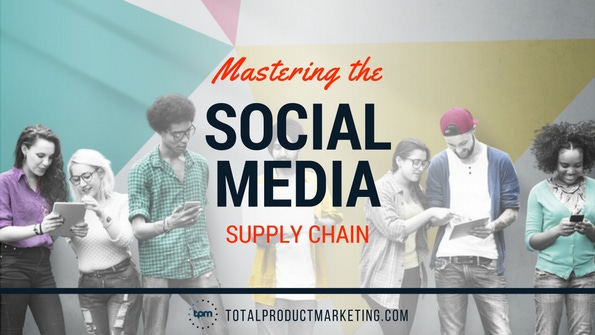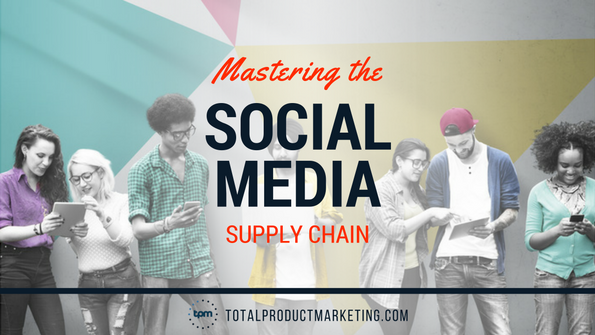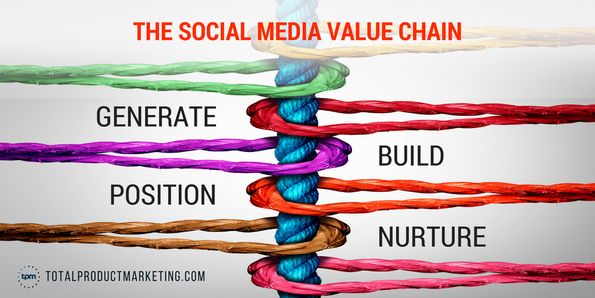Break down the social media value chain, and discover a seven-step social media strategy to unlock the power of social.
November 2, 2016

By Dean Ara

Over the past 25 years, there’s been a sweeping evolution in the social media domain and much change in how people and brands engage socially online. While it is true the first use of social media emerged in the late 1970s, it wasn’t until about 2006 that we saw social media come into the mainstream with the growing popularity of Facebook and launch of Twitter.
With the breakthrough of social communication, social media marketing has created a new world of opportunities for you, as MSP sales and marketing folks, to connect with your target audience – but only if you can master the social media value chain. In this post, you’ll learn to break down the social media value chain, and how to implement a seven-step social media strategy so you can unlock the power of social. Discover how the right approach to social media marketing can help you generate top of funnel leads and nudge them down the funnel.
If sales today is all about education, then MSPs need to invest in social channels because that’s where people discover, share, respond to, and engage with your content. People already use social media for news, information, how to’s, and conversations. Whether your sales education strategy includes content marketing or direct one-to-one sales prospecting, social can help.
At a high-level, social offers three key benefits for MSP sales and marketing professionals:
Social media builds trust and trust is your number one sales weapon. By leveraging your social channels to develop trust you will be able to generate more leads.
Social media enables social listening. Use social media to listen to your audience and find out what they care about. You can easily tune into valuable feedback, gain real insights, and eavesdrop on public conversations your customers and prospects have about you and your competitors.
Social media gives your MSP marketing and sales efforts a fighting chance. People can – one hopes – find your content via Google, SEO, and email even if you don’t have a social presence. But without one, you’re cutting off a powerful avenue that can help you reach a potentially huge pool of prospects. You’re not giving your content a fighting chance if you’re not doing some social promotion.
The Social Media Value Chain for MSPs
How do you harness the value social can bring your organization? By understanding the social media value chain and using it to your advantage! Below we have outlined the four components of the social media value chain.
Build your brand
Social media gives you visibility, lets you start conversations, and provides an opportunity to start building trust.
Your company’s image can be enhanced when you post regular updates to Facebook and Twitter, which demonstrates that you are a modern, proactive business with a continual interest in industry developments.
Generate leads and sales
Your client base is on social media, and most of them use it to help make purchasing decisions.
Nurture client relationships
Social media can contribute to your sales strategy because it lets you subtly but constantly alert customers to new products and services.
Position your company as a thought leader
You can share your knowledge and come across as an authority in your field when you use social media to educate and engage your target audience, including current clients, prospect, peers and vendors.

7 Step Strategy to Master the Social Media Value Chain
It’s important to have a strategy and plan in place before you move your MSP business into the social domain. This seven-step strategy will help you master the social media value chain.
1. Learn about your ideal audience
The more you know about your target audience – what they want and what conversations they’re engaged in – the more successful you’ll be. What are your audience’s demographics and interests? What sites do they frequent? What social channels do they use and what captures their attention there? And as you build your social following, you’ll gain many of these insights.
2. Define your goals
Set SMART social goals – goals that are specific, measurable, attainable, relevant, and time-bound. Make sure your social goals are quantifiable, tied to a specific campaign, and aligned with your overall business objectives. Try to identify goals for which you can attach a number such as:
Email list signups
Content downloads
Purchases
Inquiries for more information
3. Pick your platform(s)
To decide which social platforms to use and how best to use them, take note of the following:
LinkedIn is specifically designed for business activities. It’s an effective tool for prospecting and recruiting – and for promoting your content. You can see who’s viewed your profile and make use of features including LinkedIn Pulse, groups, company pages, and InMail.
Facebook is the largest social platform on the planet and is used primarily for personal conversations but it can be effective for business as well. Create a company page to attract fans and promote engaging content relevant to their interests. Test out Facebook ads to get additional shares, likes, and conversions based on your content. But remember this is a social place, so try not to be overly focused on sales.
Twitter gives you 140 characters to connect with your audience – so choose your words wisely. The micro-blogging tool can be a great way to promote your content with quick links and can help you build relationships with your audience. Twitter is also great for customer service and answering questions.
There are a number of other popular platforms such as YouTube, Pinterest , Google+ and many, many more – but if your time is limited, then you need to choose which platform to use. Don’t try to be on all of them; be selective and strategic to get the most out of your social media marketing.
4. Create social accounts and profiles
After you’ve prioritized and selected the platforms you want, you need to create an account for each one. Be sure to optimize your profiles and use high-quality images.

5.Determine key messages and create a calendar
Make sure you nail down what brand messages you want to use on which channels to resonate with your audience. For example, you might use Facebook for feel-good content about your company and your employees, Twitter for quick facts and statistics about MSP and hosting trends with links to your content, and LinkedIn for sales outreach. You’ll want to schedule different posts on different platforms – do NOT post the same thing on each platform. Differentiate your messaging and then create a social media calendar to keep your content fresh, interesting, and purposeful.
6.Engage!
Take time to build your social followers. Follow your customers and partners, retweet interesting and relevant content, respond to feedback, and be active where you want people to engage with you. A few tips can help you increase your social networking visibility:
Mention your online activities when you speak to customers. When you sign up new customers, encourage them to follow you on Twitter and Facebook. Tell them that you frequently post information and updates they might find useful.
Make sure links to your blog and social media feeds are in your email signature.
When you know one of your posts will be of interest to some or all of your customers, don’t be afraid to send an email linking to it.
If people interact with your posts and tweets, make sure you reply and engage them to keep the conversation going.
7.Observe and measure
Pay attention to your followers and reevaluate your messages and strategy with each campaign to get the most out of the social media value chain. Listen to the current conversations, find the top influencers in your industry, and learn what relevant hashtags are trending.
Some key metrics to measure:
Total followers and online reach
Traffic to your website
Post engagement
With the right tools, you can get even more advanced analytics and measure:
Leads
New customers
Conversion rates attributed to social

Wondering What to Post About?
If you’re not sure what to post on your social media channels, here’s a list to get your creative juices flowing:
News of significant products and industry developments
Your own blog content
Case studies, eBooks, white papers, and other valuable brand content
Reviews
Retweet items from influencers, partners, and followers
Questions and conversation starters
Humorous content
Images
Calculate the ROI on Social Media
Social should not be executed in blind faith – like any spend, you need to be able to prove the ROI. As an MSP your budget and resources are limited and therefore your time investment in social media needs to generate measurable results. However, there is no blanket approach to defining the value of social for your business. Rather, its ROI can be measured by its effectiveness in meeting the goals your organization has set.
If your goal is to generate leads or sales through social then you need to track your social media efforts. Tracking your efforts against your goals lets you evaluate which platforms and specific posts are most effective at reaching your overall goals. Tracking allows you to measure where your social leads are coming from and what value they are providing your business. If you notice some channels are more successful than others, then you may want to spend more on those and cut back on others that aren’t performing as well.
You can use a number of tools to track your social media efforts such as Google’s URL Builder, Hootsuite, or Customer LTV Calculator.
Social Success and Beyond
At the end of the day – social media requires you to be, well, social. Many companies make the mistake of over automating their social accounts and forgetting everything they know about how to build relationships. Remember that you are connecting with people and – online or offline – people still crave authentic experiences. Your use of social media will be more rewarding when you understand and leverage the social media value chain.
Want to bring your social media game to the next level? At Total Product Marketing, we specialize in marketing for Channel Partners and Cloud Service Providers. Contact us today for help in developing a social media marketing strategy to help achieve your business goals.
You May Also Like
